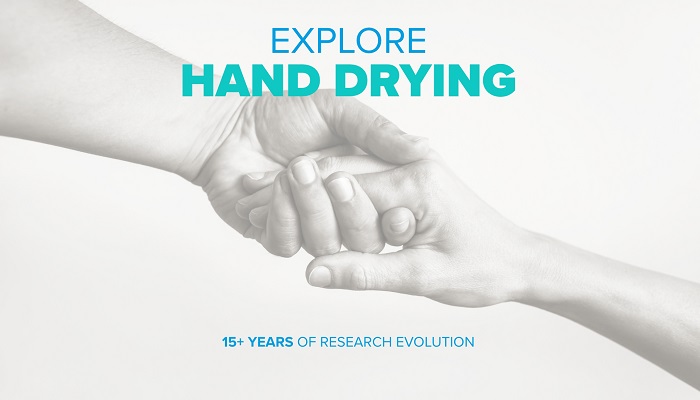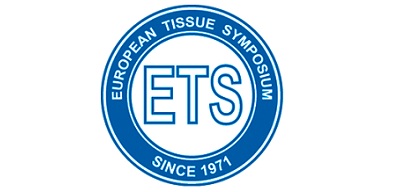Why has hand drying research been such an important focus of your work
Like all the best science I stumbled into this field by chance. I had begun to see air dryers cropping up in public washrooms and even used them occasionally. As an infection control specialist, I immediately noticed a couple of things that bothered me. Firstly, the fact that it was almost impossible to keep your hands still and not touch either the back or front of the blades during the drying process. Secondly, and this alarmed me the most, was that I could actually feel droplets of water touching my face as I dried my hands.
For someone in my line of work this is a big no no. It raised alarm bells as to the potential risk of the spread of whatever was in those droplets.
Hand drying is an integral part of the two-stage hand hygiene process – although often viewed as the poor relation to hand washing. What most people don’t know is that damp hands transmit bugs more easily. And not only do damp hands transmit pathogens more easily, they are also more likely to pick them up from touched surfaces. So, the risk is that much of the benefit of good hand washing can then be undone if it is not followed by proper hand drying. I realised that not much attention had been paid to this – and so my 15-year journey of discovery began.
When you look back over the evolution of hand drying research over the past 15 years, what stands out particularly?
Three findings in particular have really surprised me. Early on in our research I was stunned by the magnitude of the difference between splattering that occurs during hand drying when comparing the various hand drying options. In one of our first experiments, we dressed washroom users in disposable white suits and fixed white paper around the walls of the washroom. We then had people immerse their hands in black watercolour paint and dry them with different hand drying methods.
I expected there to be a difference in the spots and splattering that we then counted but the magnitude of differences were just astounding. The spots and dribbles created when hands were dried with jet air dryers was 130 times greater than when they were dried with paper towels. Warm air dryer use resulted in paint on floors and low down on the walls, but with jet air dryers the splattering was upwards, sideways and outwards. I hadn’t expected that.
A subsequent study followed people outside of the washroom after they had dried their hands using different methods. Here again the differences between contamination with viruses from hands after using a jet air dryer rather than paper towels were really stark. Something I had not expected. Our experiment had people then place stethoscopes around their neck and fold their arms, and we were alarmed to find how the viruses that had landed on the body during hand drying were then transferred onto these objects and subsequently onto other surfaces such as chair arms and door handles. On average, the levels of virus contamination of hospital surfaces were 10-fold higher following jet air dryer use than after paper towel use.
The third surprising finding was from our last study, undertaken around the time of the COVID-19 pandemic. Here the person drying their hands was wearing a high-quality face mask – just like people were wearing during the pandemic to provide high level protection against inhaling viruses. This allowed us to measure the transmission of viruses in the air and particularly the viruses that could be breathed in after hand drying – something we hadn’t really looked at before. The point here is that hands can still have bacteria or viruses on them after sub-optimal cleaning. We used a virus called bacteriophage that is harmless to humans, and had people immerse their hands in a virus solution and then dry them with either paper towels or a jet air dryer. We measured the amount of viruses that contaminated the face masks for the first five minutes after hand drying, then again for the next 5 minutes, and once again for the third 5 minute period, i.e. up to 15 minutes after initial hand drying.
What surprised us was that with jet air dryer use we were recording high amounts of viruses on the face masks during the final 5 minutes of the experiment – i.e. between 10-15 minutes after the person had initially dried their hands. This was alarming as it means that hand drying with a jet air dryer was creating virus-containing aerosols that persist and could be breathed in by anyone in the washroom more than 10 minutes after hand drying had happened. Of course, in normal situations, where people are not wearing masks, these small virus-containing particles could be breathed in and go down into the airways – potentially, by a person in the washroom well after someone had earlier dried their hands with a jet air dryer.
Your studies take place in hospitals and laboratories, so are they still relevant in ordinary public washrooms?
Absolutely. What our studies demonstrate is that microbes, especially viruses, can disperse in the air – what we call aerosolization – during hand drying. These viruses in the air could be inhaled and so pass from one person to another via the air we breathe. Also, the splattering that occurs during hand drying with jet air dryers means that your face, body and arms can become contaminated with microbes, which you may then carry with you outside of the washroom. Now we can all understand how that could pose a problem in schools, restaurants, sports complexes or any public setting. Essentially, if hands are not washed properly and then not dried optimally, we could be in trouble and risk spreading microbes and infection.
You mentioned the pandemic, which certainly placed a huge focus on good hand hygiene for all of us. Did that make you feel vindicated that your warnings were finally being heeded?
The pandemic certainly placed hand hygiene on the map. Pre-pandemic there was barely polite interest when I presented my research. Once COVID-19 hit and we all became obsessed with hygiene then yes, interest in the subject mushroomed. It transformed people’s understanding of the risks of airborne microbes, as we were suddenly confronted with real life evidence of the impacts they can have. This is certainly encouraging and spurs me to continue my work.
You raise an important point there. What is next for hand hygiene research?
The thing that we would love to do is provide absolute proof that all these elements increase the risk of infection. It is more than reasonable to assume this is the case, based on the evidence we have acquired, but to actually go out and deliver hard proof would mean following hundreds of people around for days to see what they touched, who they touched, who they kissed and hugged even, and who fell ill. It would be very difficult to separate out all the different things that people do that risk the spread or acquisition of infection. However, when it comes to needing proof of some things that just makes sense, scientists often refer to the parachute principle – we know that you need a parachute if you jump out of a plane at altitude, but we don’t go around conducting experiments where half the people have a parachute and the other half don’t in order to prove this.
For me it will be important to continue to carry out our work and to keep measuring aerosolization during hand drying – including with newly emerging drying methods. I am particularly interested in how public washrooms are organised and get very nervous when I see an air dryer on the wall close to urinals, or a child’s-level washbasin situated right next to an air dryer that could blow droplets directly into their faces. These are lightbulb moments for me and make me think that organisations would be well advised to consult Infection control specialists when designing washroom facilities.




















